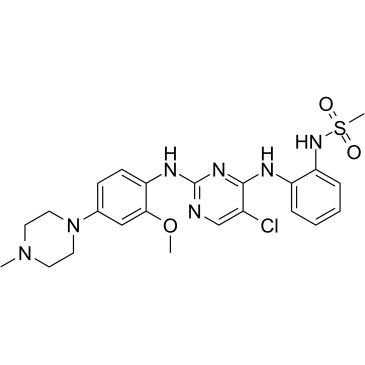| In Vitro |
ZX-29 (0-81 nM; 24-72 hours; NCI-H2228 cells) treatment leads to a time- and dose-dependent decrease in NCI-H2228 cell viability[1]. ZX-29 (10 nM; 24 hours; NCI-H2228 cells) treatment causes typical signs of autophagy and the formation of autophagosomes. ZX-29 enhances the expression level of LC3 and Beclin1[1]. ZX-29 (10 nM; 0-48 hours; NCI-H2228 cells) inhibits the proliferation of NCI-H2228 cells and arrests the cells in G1 phase[1]. ZX-29 (10-40 nM; 24-48 hours; NCI-H2228 cells) treatment induces apoptosis of NCI-H2228 cells. ZX-29 dose-dependently upregulates the expression levels of proapoptotic protein Bax, increases the production of activated forms of caspase 3, and downregulates the expression level of antiapoptotic protein Bcl-2[1]. ZX-29 (30-300 nM; 24 hours; NCI-H2228 cells) treatment significantly down-regulates the expression of p-ALK and its downstream signaling proteins, including p-Akt and p-STAT3, in a dose-dependent manner[1]. ZX-29 (20 nM; 0-48 hours; NCI-H2228 cells) treatment significantly increases the mRNA level of CHOP[1]. ZX-29 dose-dependently inhibits colony formation of NCI-H2228 cells. With an increase in ZX-29 concentration, the cell density decreased gradually, and the cells lost their normal morphology and become sharp and slender[1]. Cell Viability Assay[1] Cell Line: NCI-H2228 cells Concentration: 0 nM, 1 nM, 3 nM, 9 nM, 10 nM, 27 nM or 81 nM Incubation Time: 24 hours, 48 hours or 72 hours Result: Led to a time- and dose-dependent decrease in NCI-H2228 cell viability. Cell Autophagy Assay[1] Cell Line: NCI-H2228 cells Concentration: 10 nM Incubation Time: 24 hours Result: Caused typical signs of autophagy and the formation of autophagosomes. Cell Cycle Analysis[1] Cell Line: NCI-H2228 cells Concentration: 0 hour, 12 hours, 24 hours or 48 hours Incubation Time: 24 hours Result: Arrested the NCI-H2228 cells in G1 phase in a time-dependent manner. Apoptosis Analysis[1] Cell Line: NCI-H2228 cells Concentration: 10 nM, 20 nM or 40 nM Incubation Time: 24 hours, 48 hours Result: Promoted NCI-H2228 cell apoptosis in a dose-dependent manner. Western Blot Analysis[1] Cell Line: NCI-H2228 cells Concentration: 30 nM, 100 nM, 300 nM Incubation Time: 24 hours Result: Significantly down-regulated the expression of p-ALK and its downstream signaling proteins, including p-Akt and p-STAT3, in a dose-dependent manner. RT-PCR[1] Cell Line: NCI-H2228 cells Concentration: 20 nM Incubation Time: 0 hour, 6 hours, 12 hours, 24 hours or 48 hours Result: The mRNA level of CHOP was increased significantly.
|
